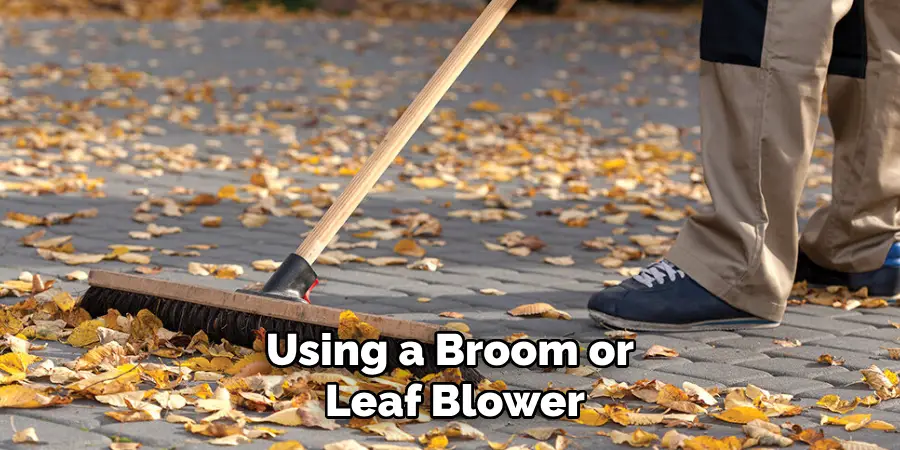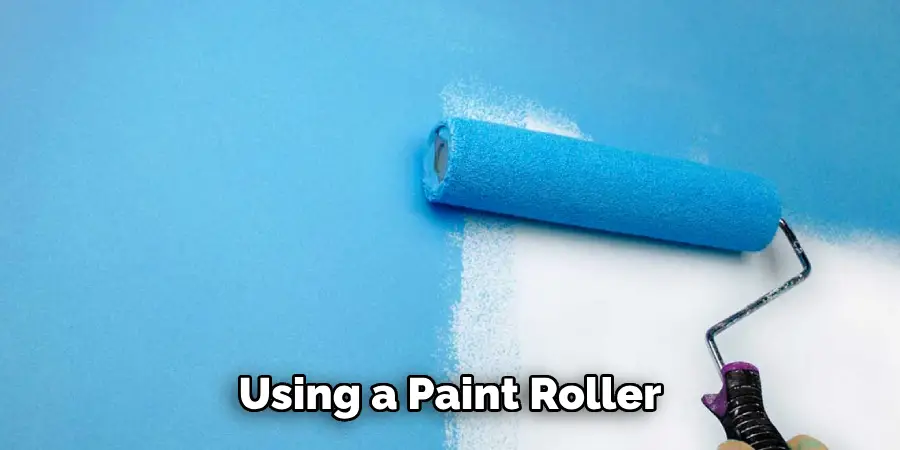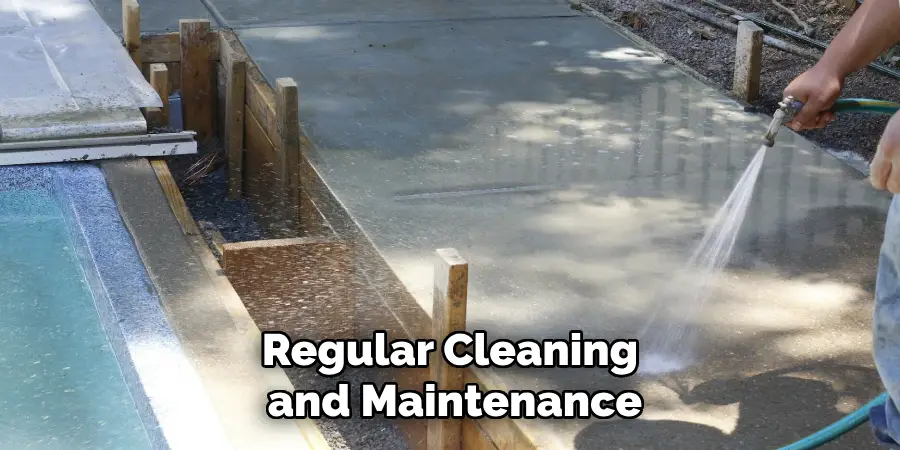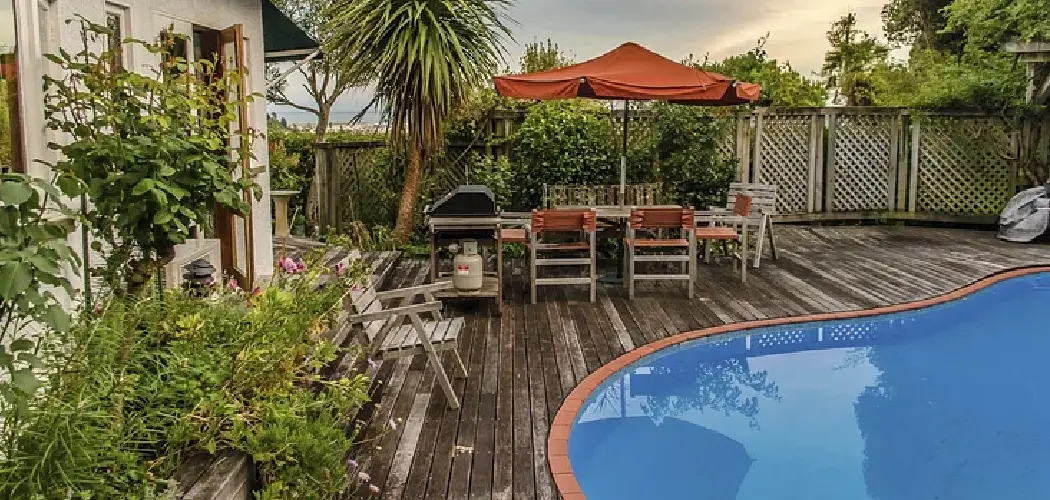Do you have an inground pool with a concrete deck that has seen better days? Over time, pool decks can become dirty and stained from regular use and exposure to the elements.

If you’re looking for a way to keep your pool area looking pristine and inviting, then cleaning the concrete around the inground pool is essential. However, it can be tricky to know how to clean concrete properly – one wrong move could irreparably damage the surface. In this post, we will provide comprehensive advice on how to clean concrete around inground pool so that it shines like new!
We’ll discuss safe tools and products, step-by-step processes for specific tasks, and more. Cleaning concrete may seem daunting, but with our expert tips and clear instructions, you’ll have an immaculate floor in no time!
What Will You Need?
Before we dive into the cleaning process, let’s gather all the necessary tools and materials. Fortunately, you won’t need fancy or expensive equipment to clean concrete around your inground pool – just a few household items will do the trick! Here’s what you’ll need:
- Broom or leaf blower
- Garden hose with high-pressure nozzle
- Scrub brush or push broom
- Bucket
- White vinegar
- Dish soap or mild detergent
- Oxygen bleach
- Stiff-bristle brush
- Sealer (optional, for finishing touch)
With these essential items on hand, you’ll be ready to tackle whatever stains and grime your pool deck may have accumulated.
9 Easy Steps on How to Clean Concrete Around Inground Pool
Step 1. Remove All Pool Accessories
Before you begin, remove any pool furniture, toys, or other accessories from the deck. This will give you a clear space to work with. It’s also essential to cover any nearby plants or landscaping with a tarp or plastic sheet to protect them from any cleaning solutions.
Step 2. Sweep Away Debris
Using a broom or leaf blower, remove all loose debris, such as leaves, twigs, and dirt, from the pool deck. This step is crucial as it will prevent larger particles from getting mixed into the cleaning solution or scratching the surface of your concrete during the scrubbing process.
Be thorough in this step, paying attention to corners and edges where debris accumulates. Once you’ve done a good sweep, use your garden hose to rinse off any remaining dust or small particles. Remember to direct the runoff away from the pool to avoid dirty water entering the pool area.

Step 3. Prepare the Cleaning Solution
Next, you’ll need to create a homemade cleaning solution. In a bucket, mix a gallon of warm water with one cup of white vinegar and a squirt of dish soap or mild detergent. If the stains are more stubborn, consider using oxygen bleach, which is safe for colors and fabrics. It’s important to note that you should never mix vinegar and bleach, as this can create harmful gases. Use a stiff-bristle brush to stir the solution until it’s well-mixed. Now, you’re ready to start scrubbing! Be sure to wear gloves to protect your hands from the cleaning solution.
Step 4. Apply the Cleaning Solution
Start by wetting a small area of the concrete with your garden hose. Then, dip your stiff-bristle brush or broom into the cleaning solution and scrub the wet area. Apply some elbow grease and ensure you’re washing all parts of the concrete, paying particular attention to stained areas. Keep dipping your brush into the cleaning solution and applying it to new areas, working in sections until you’ve scrubbed the entire deck. Let the solution sit on the concrete for about 15-20 minutes to penetrate and lift the dirt and stains.
Step 5. Rinse the Area
After waiting for the cleaning solution to penetrate, it’s time to rinse off the soap and grime. Use your garden hose with a high-pressure nozzle to thoroughly wash away the cleaning solution from the concrete. Start at one end of your deck, working your way towards the other end, ensuring you rinse all the cleaning solution off.
Be sure to direct the runoff away from your pool to prevent dirty water from contaminating the pool water. Check the area for any remaining stains. If you spot any, repeat the scrubbing and rinsing process until you’re satisfied. Allow the concrete to air-dry.
Step 6. Address Persistent Stains
If stubborn stains persist after the general cleaning, spot cleaning may be necessary. Common poolside stains such as rust, oil, or mold require a different approach.
For rust stains, a paste of lemon juice and salt can be applied and left for 15-20 minutes before scrubbing off. Oil stains can be lifted with a paste of baking soda and water, applied, scrubbed, and then rinsed. Mold stains can be treated with a mixture of one part bleach to four parts water.
After using these treatments, give the area another thorough rinse. Always wear gloves and protective eyewear when handling these more potent solutions.

Step 7. Seal the Concrete
Once the concrete is arid and you are satisfied with the cleanliness, consider applying a concrete sealer. A sealer will provide a protective layer on your concrete, which will make it more resistant to future stains, damage, and wear and tear. Choose a high-quality sealer designed for outdoor use and follow the manufacturer’s instructions for application. Generally, you will apply the sealer using a paint roller, spreading it evenly over the surface of the concrete.
Allow the sealer to dry completely before returning your pool furniture and accessories to the deck. This step is optional but highly recommended as it will make future cleaning much easier.

Step 8. Regular Maintenance
Once your concrete pool deck is clean and sealed, it’s essential to maintain its cleanliness regularly. Sweep or blow off leaves, dirt, and debris frequently to prevent buildup and potential staining. Immediate action against spills and stains will also help maintain the integrity of your concrete.
Consider repeating the cleaning process every few months as needed. Regular maintenance will extend the life of the concrete and keep your pool area looking its best.
Remember, a clean and well-maintained pool deck enhances not only the aesthetics but also the safety of your swimming pool area.
Step 9. Inspect Your Work
Once you’ve completed the cleaning and maintenance process, take some time to inspect your work meticulously. Look out for any missed spots, streaks, or remaining stains that need more attention. If you find any, repeat the necessary steps to ensure a thorough cleaning.
Additionally, check for any potential issues like cracks, chips, or signs of wear in your concrete. These could require professional attention to prevent further damage. Remember, consistent upkeep and keen observation are crucial to maintaining a clean, safe, and visually appealing pool area.
Following these simple steps, you can learn how to clean concrete around your inground pool efficiently and effectively. Regular cleaning and maintenance will not only keep your pool deck looking beautiful but also ensure its longevity.
5 Additional Tips and Tricks
- Avoid Harsh Chemicals: While it may be tempting to use potent cleaning agents for tough stains, these could potentially damage your pool’s concrete surface or alter the pool water’s chemical balance.
- Routine Cleaning: Regularly sweep or blow off leaves and other debris from the concrete to prevent stains from setting. Rinse the area with water every week to keep it looking fresh.
- Pressure Washing: For stubborn stains, consider pressure washing. Be sure to use a low-pressure setting to prevent damaging the concrete.
- Use Pool-Friendly Cleaners: Certain cleaners are specifically designed for pool areas, being non-toxic and safe for the pool water. Make sure to do your research before purchasing any cleaning products.
- Seal the Concrete: Applying a suitable quality sealant to your concrete can prevent stains from penetrating too deeply and make future cleaning easier. Sealants can also add a glossy finish to your pool area.
With these additional tips and tricks, you can keep your pool’s concrete area clean and inviting.

5 Things You Should Avoid
- Neglecting Regular Maintenance: Remember to consider the importance of routine cleaning. Ignoring this can result in stubborn stains that are more difficult to remove later.
- Using Incorrect Cleaning Tools: Avoid using wire brushes or metal scrapers, which can scratch and damage the concrete surface.
- Ignoring Stains for Too Long: Stains should be addressed as soon as possible to avoid them from setting deep into the concrete, making them harder to remove.
- Using Too Much Pressure While Washing: While pressure washing can be effective, using too high a pressure can cause the concrete to degrade and crumble.
- Overlooking Pool Water pH Levels: If you are using any cleaning agents, avoid those that could drastically alter the pH levels of the pool water. Always choose pool-friendly cleaners to maintain a safe and healthy swimming environment.
By avoiding these common mistakes, you can maintain the cleanliness and integrity of the concrete around your inground pool.
Conclusion
In conclusion, how to clean concrete around inground pool is easier than it may seem. All that’s required to clean and maintain your pool’s concrete successfully is perseverance and an understanding of the right techniques – all of which can be found in this tutorial.
There is nothing more satisfying than taking care of the concrete around your pool yourself. Don’t forget: commercial products are available if you require extra assistance, but they may contain harmful chemicals, so always read labels carefully.
Finally, use the proper tools to protect yourself and your family from any potential danger when cleaning or maintaining your pool’s surroundings. These steps will help keep your inground pool in sparkling good condition while protecting everyone from potential harm.
So start taking care of a crucial part of every swimming experience today!
About
Outdoor Fixes is a distinguished figure in the world of Diy design, with a decade of expertise creating innovative and sustainable Diy solutions.
His professional focus lies in merging traditional craftsmanship with modern manufacturing techniques,
fostering designs that are both practical and environmentally conscious. As the author of diy,
outdoorfixes delves into the art and science of outdoorfixes-making, inspiring artisans and industry professionals alike.
Education RMIT University
(Melbourne, Australia) Associate Degree in Design (Outdoor Fixes) Focus on sustainable design, industry-driven projects,
and practical craftsmanship. Gained hands-on experience with traditional and digital manufacturing tools, such as CAD and CNC software.
Nottingham Trent University
(United Kingdom) Bachelor’s in outdoorfixes.com and Product Design (Honors) Specialized in product design with a focus on blending creativity with production
techniques. Participated in industry projects, working with companies like John Lewis and Vitsoe to gain real-world insights.
Publications and Impact
In diy, Outdoor Fixes his insights on indoor design processes, materials, and strategies for efficient production.
His writing bridges the gap between artisan knowledge and modern industry needs, making it a must-read for both budding designers and seasoned professionals.

